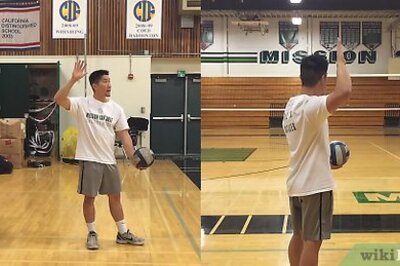
views
Tying the Albright Knot
Make a loop in 1 line and pass the end of the other line through it. If you have lines of different diameters, make the loop with the heavier line. Then, thread the lighter line through the loop back-to-front.
Coil the end of the lighter line around both ends of the loop 5-12 times. For this knot, it doesn’t matter if you make your wraps clockwise or counterclockwise. Just make sure you keep them flat, tight, and neat without overlapping or twisting the line. If your lines are drastically different sizes, make 8-12 wraps. If your lines are roughly the same size, make 5-8 wraps. If you’re using a wire leader or tippet, make sure you have a pair of pliers on hand to help you bend the wire. A leader is a transparent monofilament that connects the fly with the line.
Insert the lighter line’s end through the loop back to front. After you finish your wraps, thread the end of the lighter line through the loop at the end. Move from the back so you pull the end of the line through to the front. It doesn’t actually matter if you pass the line through the loop back-to-front or front-to-back as long as you go in the same direction you did when you started the knot.
Holding the heavy line’s ends, slide the wraps to the end of the loop. Place the tip of your finger through the loop to keep the wraps from falling off when you push them toward the end. Try to keep the wraps in a neat, flat row.
Pull the end of the lighter line to tighten the knot and clip the ends. Hold on to the ends of the heavy line. Then, pull the lighter line’s end in the opposite direction to tighten the knot. Clip the hanging ends of both lines. Lightly wet the knot to help the line stick and keep the knot tight. Alternatively, wrap the lighter line 3-5 wraps around the loop before you pull toward the loop to tighten it to make an even stronger Improved Albright Knot. Coat your knot with a drop of rubber cement to make it more secure.
Uses & Advantages of the Albright Special
It’s the best angler’s knot for tying 2 lines of different types or sizes. The Albright Knot is a great choice for joining monofilament to the braided line and braided line to the wire. It’s also one of the most common knots anglers use to tie lines that have different diameters. This is especially useful for tying a backing line to a fly line for fly fishing. Other uses for an Albright Knot are: Attaching heavy monofilament to a fluorocarbon leader. Attaching a wire bite leader to a monofilament line. Attaching a monofilament tippet to a wire bite tippet.
These knots are secure and easily slide through fishing pole guides. As a relatively smooth and low-profile knot, the Albright Special is less likely to catch on the guides of your fishing rod. When a knot catches on the guides, it can unravel or break your line.
How to Tie Other Fly Fishing Knots
Nail Knot To tie a nail knot, hold your fly and leader lines along a nail in your left hand. Make sure the pointy end of the nail is to the right. Pinch the leader to the fly line and nail it with your left hand. Leave a leader tail of 10-12 inches (25.4-30.5 cm) to make the knot. Wrap the tail end of the leader around the fly and leader lines and nail in your left hand. Make 6-8 coils, moving from your left hand toward the pointy end of the nail. Make sure you keep the coils close together without twisting or overlapping. After you make your coils, thread the end of the middle of the knot along the nail. Transfer the knot to your right hand, pinching it with your thumb and finger. Carefully pull the nail out to the left, and then pull on the ends of the leader to tighten the knot. Trim excess tails off the fly and leader lines. This knot is a good choice for tying the leader line to the fly line.
Uni Knot Start a uni knot by passing about 6-8 inches (15.2-20.3 cm) of the backing line around the spool arbor (or bar in the center of the spool). Cross the line’s tail over to make a loop. Wrap the tail around both sides of the line passing through the reel. Then, coil the tail 6-8 times, passing through the loop with each wrap. Pull the tail to tighten the knot onto the main backing line. Tug on the main backing line to pull the knot snug against the reel. Pull the tail to re-tighten the knot, and then trim it close to the knot. Use this line to attach the backing line to the reel.
Surgeon’s Knot Place the 2 lines you want to join together with their ends pointing in opposite directions. Hold the 2 lines together to make a loop for tying a basic overhand knot. Pass the lines through the loop twice to make a Surgeon’s Knot. Pull all 4 strands to tighten the knot. Trim the ends. Your finished knot looks a little like a figure 8. This knot is easy to tie and a good choice for joining 2 pieces of monofilament together.



















Comments
0 comment